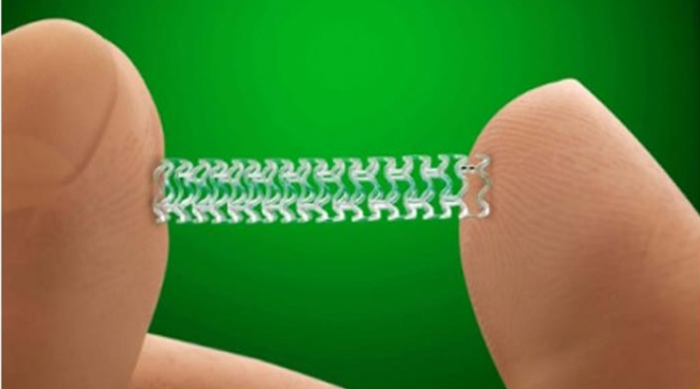This Disappearing Heart Device Disappeared Altogether
Trivia Tuesday: What cardiovascular device did Abbott pull from the market just a little more than a year after winning FDA approval?
November 28, 2023
.png?width=850&auto=webp&quality=95&format=jpg&disable=upscale)
Abbott was the first company to bring a drug-eluting bioresorbable vascular scaffold (BVS) to market, having received a CE mark for its Absorb BVS in January 2011 and FDA approval in July 2016.
But the Absorb BVS never enjoyed widespread adoption and clinical data on the device was mixed. The device was also the subject of an FDA safety alert in March 2017 linking Absorb to a higher rate of major adverse cardiac events. So, it wasn't a complete surprise when, little more than a year after FDA approval, Abbott decided to take the Absorb BVS off the market.
The structure of the Absorb GT1 BVS was made of poly(L-lactide), a biodegradable polymer that dissolves over about three years, leaving the patient's artery free of permanent implants except for four tiny platinum markers in the artery walls denoting placement.

Image of Abbott Absorb BVS courtesy of Abbott, via MD+DI archives
Abbott's CEO at the time, Miles White, described Absorb as a "very niche product," and he noted that physicians were more interested in a more deliverable stent than they were a bioabsorbable coated stent. So, the company turned its attention to the Xience Sierra, a follow-up to its Xience drug-eluting stent. The Sierra drug-eluting stent offered more sizes, better deliverability, and improved imaging tools.
A company spokesperson told MD+DI at the time that Abbott would incorporate learnings from Absorb into a second-generation bioresorbable technology with a smaller profile and improved deliverability to reduce implantation time. However, not much news has emerged on the project since then.
That said, a researcher from the Icahn School of Medicine at Mount Sinai did report significant findings earlier this year from a global trial that could lead to advancements and improvements in new BVS technology and future clinical use among interventional cardiologists across the United States.
The multi-center trial examined the long-term safety and effectiveness of percutaneous coronary intervention using the Absorb BVS. Five-year results from the ABSORB IV trial were presented in May at the EuroPCR meeting in Paris and published in the Journal of the American College of Cardiology.
The study showed that Absorb, when implanted with optimal technique, resulted in similar five-year rates of patient-oriented adverse events, quality of life, and recurrent angina as the standard metallic drug-eluting stent, according to lead author Gregg W. Stone, MD, director of academic affairs for the Mount Sinai Health System and a cardiology professor at Icahn Mount Sinai. Stone acknowledged that some adverse events were more common within the first three years, prior to the scaffold's complete bioresorption. Thereafter, he said, event rates were nearly identical with BVS and metallic stents.
"The early excess risk could likely be eliminated with an improved thinner next-generation scaffold and its implantation with intravascular imaging guidance, affording long-term restoration of the coronary artery to its original native state without a permanent implant," Stone said. "There is a real desire among patients and their doctors for an absorbable stent which is present early while it is needed and then completely disappears. The favorable long-term results from this study emphasize the fact that this novel technology, which was voluntarily withdrawn from the market by the manufacturer due to lower than expected market adoption, should not be abandoned.”
About the Author(s)
You May Also Like



.png?width=300&auto=webp&quality=80&disable=upscale)
